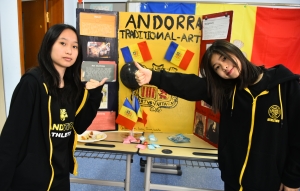Academics
Science Introduction
With science and
technology at the forefront of modernity and a global world-view,
science courses at SMIC are designed to plant seeds of curiosity into
the hearts and minds of students. After completing a course, a student
will have a foundational understanding of how science works and the
place that it has in our world today. Furthermore, students will be able
to establish academic foundation that allows them to build connections
between scientific concepts, their own lives, their communities, and the
world at large. With the combination of available contemporary
technology together with more traditional pedagogical approaches,
activities and experiments are designed to excite, engage, and provide
students with opportunities to deeply explore science. Project-based
learning, scientific inquiry, hands-on-learning, dialogue, and
cooperative learning is emphasized in order to support all students in
their weaknesses and to expand on their individual strengths.
Middle School Curriculum
Grade 6
-How do plate tectonics impact the surface of Earth?
-How do people figure out that the Earth and life on Earth have changed over time?
-How do the materials in and on Earth’s crust change over time?
-Energy flows and matter cycles
-How does water influence weather, circulate in the oceans, and shape the Earth’s surface?
-Natural processes and the affects on society
Weather, Water, & Space:
-What factors interact and influence weather and climate?
-What is the relationship between humans and climate? How might it change?
-How do human activities affect Earth’s water systems?
-What is the history of water on Earth?
-What is Earth’s place in the Universe?
-What makes up our solar system?
-How can humans explore outside of Earth?
Grade 7
-Microscope labs
-Organelles and functions
-Photosynthesis and cellular respiration
-Cell division
-DNA as genetic material
-How are genes passed?
-Project based learning
-History of life on Earth
-Extinctions and fossils
-Evidence of evolution
-Cooperative projects
System Structures, Ecosystem Dynamics, & The Human Body:
– Animal and plant classification
-Flower reproduction
-Scientific names
-How does energy flow in an ecosystem?
-How do huans interact with their ecosystems?
-How is food digested?
-Human body systems
-Interactions and relationships between organ systems
-Nutrition
Grade 8
-Velocity, acceleration, friction, momentum
-Newton’s Laws
-Fluids and Pressure
-Work and Power
-How are simple machiens involved in day-to-day life?
-In what ways is the human body like a machine?
-Humans and Energy
-How does matter behave?
-How does matter change?
-What is energy?
Middle School Science Learning Outcomes:
-Cultivate and nurture a passionate scientific curiosity about the universe.
-Create opportunities for students to make connections between scientific concepts, themselves, community, and the world at large.
-Deeply Explore the nature of science through project based learning, inquiry, and cooperative learning.
Atoms, Electromagnetic Waves, & Electricity:
-The periodic table of elements
-Trends, tendencies and behavior of elements
-Chemistry foundations
-Energy and waves
-Sound
-Light
-Wave dynamics and interactions
-How is electricity generated and useful?
-What makes something magnetic?
-Electric revolution





